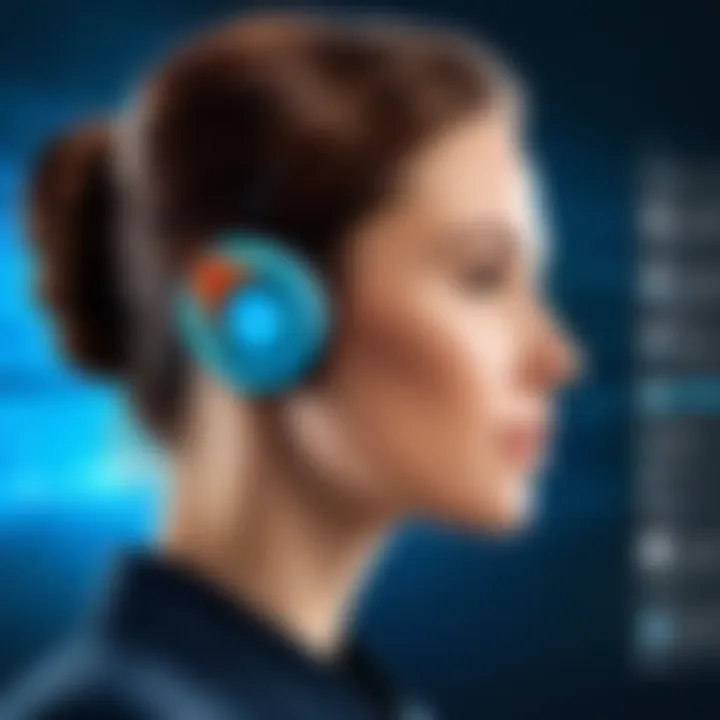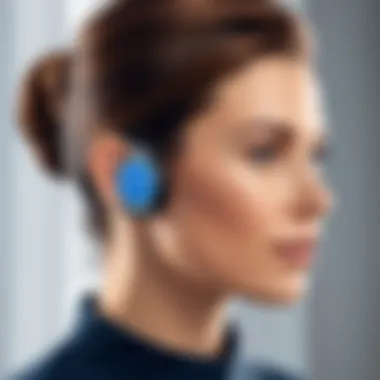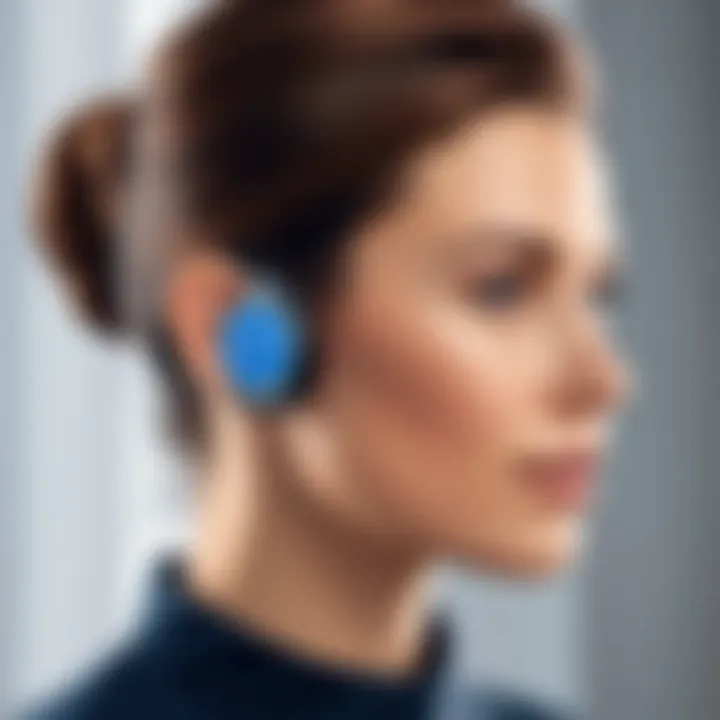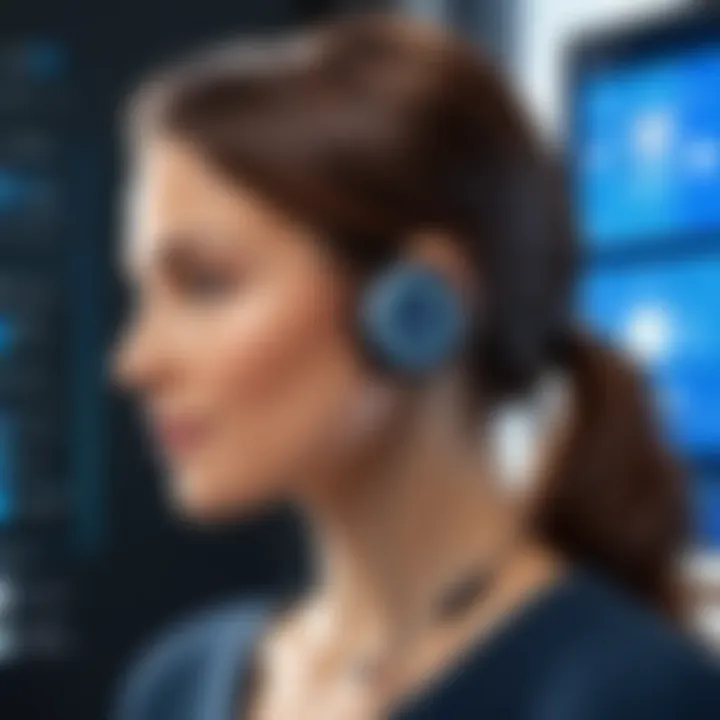Connect Bluetooth Hearing Aids to Windows 10 Easily


Intro
In today's technology-driven age, staying connected is vital, especially for individuals relying on hearing aids. The advancement of Bluetooth technology has made it increasingly easy to integrate these devices with various gadgets. However, connecting Bluetooth hearing aids to a Windows 10 device can sometimes feel like trying to hit a moving target. It’s not just about clicking a few buttons; it involves knowing the ins and outs of both your hearing aids and your computer settings.
By providing clear instructions and tips, this guide aims to simplify the connection process while addressing potential hiccups along the way. We’ll explore initial setups, common issues that might crop up, and ways to optimize your experience with these devices. Whether you're someone who geeks out on tech or just trying to make life a bit easier, this article is tailored for you.
Understanding the technicalities behind connecting Bluetooth hearing aids promotes accessibility and enhances the overall user experience.
Product Overview
Connecting Bluetooth hearing aids to Windows 10 is not merely a technical necessity; it is essential for improving the quality of life for many users. The market today boasts a plethora of Bluetooth-compatible hearing aids, each tailored to meet various needs.
Key Features
- Wireless Connectivity: This feature allows users to connect their hearing aids without any physical connection. It means freedom of movement and ease of use, whether you're working at a desk or on the go.
- Direct Audio Streaming: Some hearing aids allow streaming audio directly from your Windows device, providing high-quality sound without interference.
- Customizable Settings: Most modern Bluetooth hearing aids come with an app that enables adjustment of sound profiles according to personal preferences.
Specifications
Though specific specs can vary significantly from brand to brand, here are some common specifications to consider:
- Bluetooth Version: Look for hearing aids that use Bluetooth 5.0 or higher for better range and energy efficiency.
- Battery Type: Many hearing aids use rechargeable lithium-ion batteries, providing extended life and convenience.
- Compatibility: Ensure that the hearing aid brand you choose is compatible with Windows 10. Most reputable brands will specify this information in their product details.
Performance Analysis
Understanding performance is crucial in evaluating how Bluetooth hearing aids function within a Windows 10 environment.
Speed and Efficiency
Connections should be fast and seamless, allowing users to switch between devices without delay. When configured correctly, users can expect a prompt connection; often, it takes just a few seconds for devices to pair.
Battery Life
Battery life can be a defining factor in user experience. High-quality hearing aids tend to offer longer battery life, with many providing up to 24 hours of use on a single charge. It's essential to monitor battery levels and ensure devices are charged to avoid interruptions during use.
"A seamless connection can transform the user experience, providing both clarity in sound and convenience in use."
Regular updates and firmware are also important, as manufacturers may provide enhancements that improve efficiency and functionality over time. Users should not hesitate to check for updates for both their hearing aids and their Windows operating system to ensure optimal performance.
By addressing these features and performance metrics, we can better appreciate how to connect and use Bluetooth hearing aids effectively in a Windows 10 environment.
Understanding Bluetooth Hearing Aids
Understanding how Bluetooth hearing aids work opens up a world of possibilities for users. As technology evolves, hearing aids have not only become more efficient but also more integrated in our daily digital experiences. These devices, once solely mechanical, now rely heavily on sophisticated software and connectivity features, particularly Bluetooth, to enhance user experience.
What are Bluetooth Hearing Aids?
Bluetooth hearing aids represent a modern leap in audiology. Unlike traditional hearing aids that simply amplify sound, these devices utilize Bluetooth technology to connect directly to other digital devices, such as smartphones, tablets, and computers. This connectivity allows users to stream audio directly into their hearing aids, making phone calls, music, and video conferencing clearer and more convenient.
For instance, if you're watching a movie on your laptop, you can stream the sound directly to your hearing aids without needing to crank up the computer's volume. This feature not only saves hearing aids from the strain of processing background noise but also allows for a more immersive viewing experience. In essence, Bluetooth hearing aids enhance auditory perception by eliminating the middleman—your device's speaker—making every sound crisp and clear.
Benefits of Bluetooth Connectivity for Hearing Aids
Seamless Integration with Daily Life
Bluetooth connectivity significantly broadens the functionality of hearing aids. Users can enjoy a host of benefits, including:
- Direct Audio Streaming: This feature provides sound directly from a smartphone or any Bluetooth-enabled device, allowing for richer audio experiences without external distraction.
- Remote Control Functionality: Many brands offer companion apps that turn smartphones into remote controls for hearing aids. Users can modify settings, adjust volume, and switch listening modes directly from their devices.
- Multi-Device Connectivity: Some Bluetooth hearing aids can connect to multiple devices at once. This means users can switch seamlessly between their phone and computer without needing to re-pair each time.
- Enhanced Communication: Bluetooth hearing aids facilitate clearer conversations by streaming calls and enhancing speech recognition.
"In a world increasingly driven by technology, connecting your hearing aid to devices can feel like opening a door to improved quality of life."
When considering these advantages, it becomes evident why understanding Bluetooth hearing aids is not just an optional exercise but a necessity for modern users. They can empower individuals to navigate their environments with greater ease, integrate more fluidly with their electronic ecosystems, and ultimately foster a more fulfilling auditory experience in a noisy world.
Prerequisites for Connecting Hearing Aids to Windows
Connecting Bluetooth hearing aids to your Windows 10 device is not just a plug-and-play exercise. It requires a clear understanding of the necessary prerequisites. This ensures both your hardware and software are up to snuff, paving the way for a seamless and efficient connection.


Compatible Devices and Systems
Before diving into the connection process, it’s crucial to confirm that both your hearing aids and Windows 10 computer are compatible. Most modern hearing aids from reliable brands like Phonak, Oticon, or ReSound boast Bluetooth capabilities designed to interact with various devices.
However, not all Windows 10 systems are equipped to recognize these devices right off the bat. Look out for:
- Bluetooth 4.0 or higher: This is key because older Bluetooth versions may not offer the stability or range required for hearing aids. Check your device specifications before proceeding.
- Windows 10 Updates: Ensure your operating system is up to date. Newer versions often include enhancements in Bluetooth connectivity.
With these factors in mind, verify that your hearing aids can be paired. Reference the user manual or visit your manufacturer's website. You’d be surprised at how often compatibility issues pop up when you skip this step.
Required Software and Drivers
Once you've verified your devices are compatible, the next thing to check is your software. Depending on the manufacturer of your hearing aids, there may be necessary software or drivers required for effective pairing with Windows 10.
- Hearing Aid Software: Some manufacturers offer dedicated apps, such as myPhonak or Oticon ON, which might need to be installed on your system to optimize performance. Even if these apps aren’t explicitly for Windows, having them on hand can help manage your device settings more efficiently.
- Bluetooth Drivers: Ensure you have the latest Bluetooth drivers. Go to the Device Manager, find your Bluetooth adapter, and check for driver updates. Windows usually does a decent job at this, but checking manually might save some headaches down the line.
By ensuring your software and drivers are aligned before attempting the connection, you minimize the chances of running into roadblocks that could frustrate the experience.
Remember: Connecting your Bluetooth hearing aids is not only about making them work with Windows 10; it’s about enhancing your overall auditory experience. A smooth connection ensures you can enjoy all the features intended by the device manufacturers.
Preparing Your Windows Device
Before diving into the world of Bluetooth hearing aids, it's important that your Windows 10 device is properly set up. This preparation phase can be seen as laying the groundwork for a smooth connection. If your settings are off or the system is lagging, expect frustration during the pairing process. Here’s what you need to focus on for a seamless experience:
Accessing Bluetooth Settings
Finding the Bluetooth settings on your Windows 10 device is the first step in this journey. To access this crucial area:
- Click on the Start Menu: Look for the Windows icon, usually found on the bottom left of the screen.
- Select Settings: This gear-shaped icon will give you access to various systems options.
- Go to Devices: In this section, you'll find all the connected devices and their configurations.
- Navigate to Bluetooth & Other Devices: Turn the Bluetooth toggle to "On" if it's not already activated.
Once in this realm, you can also manage existing device connections. Removing any old or unused Bluetooth devices might ease your setup process. Each step is crucial, as only one device can be paired at a time.
Updating Windows for Optimal Performance
Keeping your Windows 10 updated is akin to maintaining a well-oiled machine. Updates often come with bug fixes and optimizations that can enhance overall performance. Here’s how you can ensure your system is up-to-date:
- Open Settings: Head back to that gear icon in the Start Menu.
- Choose Update & Security: This section is where all your updating magic happens.
- Click on Check for Updates: Let the system search for any pending updates and install them if available.
Additionally, updating drivers is vital. Outdated Bluetooth drivers can lead to connection hiccups.
Tip: Ensure you restart your computer after applying updates to finalize installs and clear any existing system cache that might disrupt your new connection.
Staying on the cutting edge with updates not only prevents potential issues during your hearing aid setup but also boosts your overall user experience on Windows 10.
By thoroughly preparing your device, you're creating a solid foundation for connecting your Bluetooth hearing aids. This preparation may seem mundane, but it plays a pivotal role in ensuring that everything runs smoothly.
Pairing Your Bluetooth Hearing Aids
Pairing your Bluetooth hearing aids with Windows 10 is an essential step to enjoying the full range of sound and functionality these devices offer. It's more than just connecting; there's a world of audio clarity waiting for you. When hearing aids are properly paired, users unlock features like direct streaming of music, phone calls, and notifications, making daily tasks seamless. This step facilitates an integrated experience, blurring the line between assistive technology and core communication tools. The absence of this pairing can be frustrating, leading to missed connections and diminished audio experiences. Moreover, understanding the pairing process not only simplifies the setup but also enhances overall satisfaction.
Enabling Pairing Mode on Hearing Aids
To kick off the pairing process, the first order of business is ensuring your hearing aids are in pairing mode. Generally, this involves a simple combination of button presses or movements on your device.
- Check the Manual: Each hearing aid can have its own method based on the manufacturer. For instance, devices from Phonak or Oticon might require pressing a specific button for a few seconds.
- Indicator Lights: Usually, when in pairing mode, light indicators on the hearing aids may blink or change color. This is your visual cue that your hearing aids are ready to connect.
- Lasting Duration: Keep in mind that pairing mode can time out. If not completed in a set period, you might need to re-initiate the pairing mode.
This might sound trivial, but ensuring your hearing aids are ready to go can save you time and stave off frustration down the line. One seeker of clarity reported being nearly driven to distraction, mainly because they overlooked this crucial step.
Initiating the Pairing Process on Windows
Now, if your hearing aids are in pairing mode, it’s time to direct the show from your Windows 10 device.
- Go to Settings: On your computer, navigate to the 'Start' menu. Click on 'Settings' and find 'Devices'.
- Bluetooth & other devices: Within the device settings, toggle on Bluetooth if it isn’t already. Then select 'Add Bluetooth or other device.'
- Select Bluetooth: Choose the Bluetooth option when prompted. This should prompt a search for nearby devices.
- Select Your Hearing Aids: When your hearing aids pop up on the list, select them to initiate pairing.
- Follow On-Screen Prompts: Windows may provide additional instructions, and it's vital to follow these closely.


This process may be as straightforward as pie, but failing to follow the correct prompts can leave you scratching your head.
Confirmation of Successful Connection
Once the devices have attempted to pair, you should receive visual feedback from Windows 10 that the connection was successful. You might see a notification pop-up affirming the connection. Additionally:
- Sound Checks: Play a test sound or song to confirm you’re hearing it through your hearing aids. If sounds are clear, congratulations! You're connected.
- Indicator Behavior: Check back on your hearing aids. A solid indicator light can often reassure you that everything is in working order.
Remember, a successful connection not only simplifies your tech experience but also enriches your daily interactions with sound, bringing clarity where there might have been confusion.
In case you're not getting the connection, do a quick review of steps and ensure you started pairing on both devices correctly. Sometimes, it's just a minor glitch and a restart can do wonders.
Adjusting Audio Settings for Hearing Aids
When it comes to connecting Bluetooth hearing aids to Windows 10, adjusting the audio settings is a crucial step that often gets brushed aside. Without the right adjustments, the hearing aids may not deliver their full potential, meaning the user could miss out on a world of sound clarity. We need to focus on how these audio settings allow for a personalized hearing experience tailored to individual preferences. That’s where the magic happens—getting the sound just right for your ears.
Navigating Sound Settings
To navigate the sound settings on Windows 10 is like finding your way through a familiar neighborhood; it might look daunting at first, but once you know where to look, everything falls into place. Start by right-clicking the speaker icon in the system tray, which is usually tucked in the bottom right corner of the screen. From the context menu, select "Sounds". This opens up a new window filled with various tabs.
- Playback: This tab shows your connected audio devices. Your Bluetooth hearing aids should be visible here once connected. If they aren’t showing up, it could mean they need to be paired again.
- Recording: While this is more about input, it’s worth checking to make sure your microphone settings aren’t interfering with other sound outputs.
- Communications: This section allows you to adjust how your system behaves when you're in a call, which is critical for those using the hearing aids for phone conversations.
Essentially, these settings are your control center. Fine-tuning here can significantly enhance how you experience sound through your hearing aids.
Choosing Default Playback Devices
Once your hearing aids are connected, picking them as your default playback device is a straightforward but vital step. This ensures that all audio—from music to system sounds—routinely flows through your hearing aids, not some other device.
- Within the "Playback" tab mentioned above, right-click on your hearing aids and select "Set as Default Device". This will allow all sound to direct through them automatically.
- To ensure audio quality, it’s advisable to adjust any specific formats under the properties. A little tinkering can often yield a push in audio quality.
- Don't forget to apply changes and close the settings window. Otherwise, you might find your sound preferences reverted the next time you boot up!
Adjusting audio settings is not merely a technical necessity; it’s about reclaiming the sound experience users deserve. Each individual has unique auditory preferences.
By taking the time to really understand how to manipulate these settings, users can transform their hearing experience, making it not only clearer but far more enjoyable.
Troubleshooting Common Connectivity Issues
When it comes to connecting Bluetooth hearing aids to Windows 10, the process can sometimes feel like navigating a minefield. That's where troubleshooting common connectivity issues comes into play. This section is crucial because even the most advanced technology can encounter hiccups. Knowing how to address these problems is essential for anyone relying on these devices for day-to-day functioning, whether they're tech enthusiasts or seasoned users.
Identifying the root causes of connectivity problems not only saves time but enhances user experience. Furthermore, it empowers users with the knowledge to manage their devices effectively. The frustration of a dropped connection or difficulty connecting can be daunting, but understanding potential issues allows for a smoother, more satisfying experience.
Identifying Common Problems
Troubleshooting begins with recognizing the signs of an issue. So, what common frustrations might you encounter?
- Device Pairing Failures: This is a frequent nuisance. You might find that your hearing aids won’t connect or detect your Windows 10 device at all. This could be due to a variety of factors, from low battery power to incorrect settings on either device.
- Intermittent Connectivity: Sometimes the connection works fine, but other times it seems to cut in and out like a poor radio signal. This can be incredibly frustrating, particularly in the middle of a conversation.
- Audio Quality Problems: You might find that while the devices connect, the audio quality is less than stellar. Issues like delay or distortion can sap the enjoyment from what should be a simple listening experience.
- Software Conflicts: Other software on your Windows 10 device might interfere, particularly if you're running multiple audio applications. This can lead to unexpected disconnections or audio routing issues.
Identifying these common problems is the first step toward a seamless experience.
Effective Solutions and Workarounds
Once you spot the trouble spots, the next step is applying some fixes. Here are some practical steps that can resolve many of these pesky problems:
- Check Battery Levels: First things first; ensure that your hearing aids are fully charged. A low battery can lead to connectivity issues that may appear to be software-related.
- Reset Bluetooth Connection: Sometimes, simply toggling the Bluetooth off and on again can resolve intermittent issues. Go into your Windows settings, disable Bluetooth, wait a moment, and then re-enable it.
- Re-pair the Device: If pairing fails more than once, forget the device from your Windows list and then try reconnecting. This often refreshes the connection.
- Update Drivers: Outdated drivers can be a cause of incompatibility. To ensure optimal performance, regularly check for updates in your Windows device manager. Keeping software up to date reduces many issues before they arise.
- Audio Settings Adjustments: Go into sound settings and ensure your hearing aids are set as the default playback device. Sometimes they may be detected but not prioritized.
As you troubleshoot, remember to take a breath and check each step methodically.
"It is the little things that you do every day that create great things over time."
With patience and persistence, many of the issues that can arise during the connection process can be effectively resolved. The essential thing is to remain aware, informed, and ready to tackle these common connectivity issues head-on.
Maintaining Optimal Performance of Hearing Aids
Maintaining the optimal performance of Bluetooth hearing aids is essential for users to experience clear audio, effective sound amplification, and overall satisfaction with their devices. Hearing aids, being sophisticated pieces of technology, require regular upkeep and calibrations to function at their best. Neglecting these practices can lead to issues such as diminished sound quality or connectivity problems.


When it comes to hearing aids, a stitch in time saves nine. Regular maintenance not only prolongs the life of these devices but also enhances user comfort and hearing capabilities. Imagine struggling to hear conversations or missing critical auditory cues. By being proactive, users can mitigate these frustrations.
Routine Maintenance Tips
Keeping your hearing aids in good shape might seem like a daunting task, but it boils down to a few simple habits that can be easily integrated into your daily routine. Here are some practical tips:
- Daily Cleaning: Wipe down your hearing aids every evening. Use a soft, dry cloth to remove moisture, dirt, and earwax.
- Dehumidification: Utilize a dehumidifier specifically designed for hearing aids. This helps remove moisture that can build up during the day, especially if you're in humid environments.
- Battery Checks: Regularly inspect batteries for signs of wear. Fresh batteries are crucial for optimal sound performance. Always keep a spare set handy.
- Storage Practices: Store your hearing aids in a case when not in use. This protects them from damage and keeps them free from dust.
- Professional Checkups: Schedule routine visits with your audiologist. They can ensure your devices are functioning correctly and make adjustments if necessary.
Incorporating these habit into your routine can be as easy as pie, allowing you to enjoy seamless hearing every day.
Upgrading Firmware and Software
In today's digital age, staying updated is everything. Software upgrades for Bluetooth hearing aids can significantly enhance features, fix bugs, and improve overall performance. Here’s why you should consider upgrading:
- Enhanced Features: With firmware updates, manufacturers often add new functionalities or optimize existing ones, allowing users to have better control over their listening experience.
- Bug Fixes: Just like any other tech, hearing aids can have glitches. Updating software can solve known problems and help prevent new ones.
- Compatibility Improvements: As operating systems and other tech evolve, firmware updates ensure that hearing aids work well with the latest devices.
To upgrade your hearing aids:
- Connect your hearing aids to a compatible device using Bluetooth.
- Open the manufacturer’s app or software to check for available updates.
- Follow the prompts to download and install the updates.
Keep in mind the classic saying, "If it ain't broke, don't fix it" - that's not entirely applicable here. Updating your devices can be a simple yet crucial decision in maintaining effective use of hearing aids. Stay ahead of the curve; an updated device not only enhances your experience but also ensures you're getting the most out of your technology.
"Optimal performance means not just hearing, but really listening. Make the small efforts, and the rewards will be clear sound and enhanced life quality.”
A little effort towards maintenance can go a long way in enjoying the full benefits of Bluetooth technology in hearing aids. By following these tips and being proactive, users can ensure long-lasting, effective auditory support.
Privacy and Security Considerations
In our digital age, where technology steadily intertwines with our daily lives, the need to understand privacy and security considerations when it comes to Bluetooth devices cannot be overstated. This is particularly crucial for users of Bluetooth hearing aids, who rely on these devices for better communication and connectivity. While these devices enhance auditory experiences, they also carry a set of vulnerabilities that can compromise personal information. Recognizing the importance of safeguarding your data is the first line of defense against any potential threats that might arise.
Understanding Bluetooth Security Risks
Bluetooth technology operates within a complex framework that, while generally secure, is not infallible. One of the primary risks users face is that Bluetooth connections can be susceptible to interception. Attackers can exploit vulnerabilities in the Bluetooth protocol, especially if devices are not updated with the latest software.
For instance, using weak pairing methods can invite trouble. Such methods may allow unauthorized access to your hearing aids or other paired devices. There have been instances where attackers were able to execute what we call bluejacking, leading to unsolicited messages or, worse, bluesnarfing, where unauthorized data access occurred.
Here are some additional risks to consider:
- Eavesdropping: Malicious actors can intercept communications between your hearing aids and Windows 10 if the connection is not secured.
- Spoofing: An attacker might mimic your device to gain access, tricking others into believing they are communicating with a legitimate device.
- Firmware Vulnerabilities: Outdated firmware on your hearing aids can expose you to threats that exploit known weaknesses.
Staying informed about these risks arms you with the knowledge to enhance the security of your personal devices.
Best Practices for Data Protection
Taking a proactive approach to data security can significantly mitigate potential risks associated with Bluetooth hearing aids. Adhering to best practices not only protects your personal information but also ensures a smooth user experience. Here are some essential guidelines to bolster your data protection:
- Regular Software Updates: Make it a habit to check for and install firmware updates for your hearing aids. These updates often contain important security patches that address vulnerabilities.
- Use Strong Pairing Techniques: Opt for secure pairing methods. Avoid using easy-to-guess PINs or passcodes when connecting your devices.
- Bluetooth Visibility Settings: Change your Bluetooth settings to make your hearing aids discoverable only when necessary. Keeping them hidden from the public can reduce the chances of unauthorized access.
- Disconnect When Not in Use: If you’re not using your Bluetooth hearing aids with Windows 10, disconnect them. This step prevents any possible unwanted pairing attempts.
- Monitor Connection History: Regularly check the devices paired with your hearing aids. Remove any unknown devices that might have access.
By taking precautions and staying informed, users can enjoy the benefits of Bluetooth technology in their hearing aids without falling prey to security vulnerabilities.
Closure
Connecting Bluetooth hearing aids to Windows 10 is not just a technical task; it’s a bridge between cutting-edge technology and everyday accessibility. This guide simplifies the process, ensuring that users can easily adapt to the digital world while enhancing their auditory experience. The steps detailed in this article equip individuals with the knowledge to manage their devices effectively, unraveling the complexities often associated with Bluetooth connections.
Summarizing Key Points
In this guide, essential elements were discussed:
- Understanding Bluetooth Hearing Aids: It’s crucial to grasp what Bluetooth hearing aids are and how they enhance communication.
- Prerequisites: Knowing what devices and software are necessary sets the foundation for successful connectivity.
- Preparing Windows 10: We covered how updating and accessing Bluetooth settings streamlines the connection process.
- Pairing Process: Detailed steps on how to enable pairing mode and initiate the connection were provided, ensuring a successful setup.
- Audio Settings: Adjusting audio settings ensures that the hearing aids function optimally.
- Troubleshooting: Common issues were identified, with practical solutions outlined to help users overcome obstacles.
- Maintenance Tips: Keeping hearing aids in top shape was discussed, highlighting the importance of routine checks and firmware updates.
- Privacy and Security: Addressing Bluetooth’s security aspects helps users safeguard their devices against potential risks.
This concise summary of key points underlines the importance of a structured approach to connecting Bluetooth hearing aids.
Future Trends in Hearing Aid Technology
Looking ahead, the future of hearing aid technology shines brightly. With rapid advancements, we are likely to witness some intriguing developments:
- Increased Integration: Future hearing aids will probably integrate seamlessly with various smart devices, such as smartphones and home automation systems, allowing users to control their environments without hassle.
- AI-Powered Features: Artificial intelligence is anticipated to play a pivotal role, with hearing aids adapting automatically to the user’s environment and preferences.
- Telehealth Capabilities: Remote diagnostics could become standard, enabling audiologists to adjust settings and provide assistance from afar, making care more accessible.
- Enhanced Audio Processing: Expect more sophisticated sound processing technology that improves clarity and reduces background noise, resulting in a richer auditory experience.
- Sustainability: As eco-consciousness grows, manufacturers may shift towards sustainable materials and methods in the production of hearing aids.
In sum, these trends indicate a promising future where hearing aids evolve into even more indispensable tools, offering unprecedented connectivity and personalized experiences. This bright outlook not only enhances daily interactions for users but also emphasizes the importance of staying informed about the rapidly changing landscape of hearing technology.



